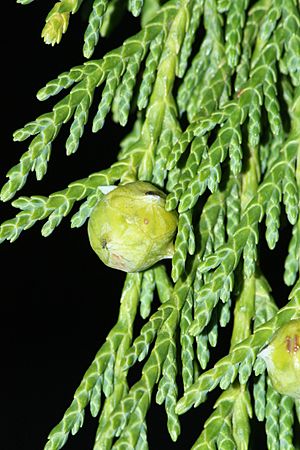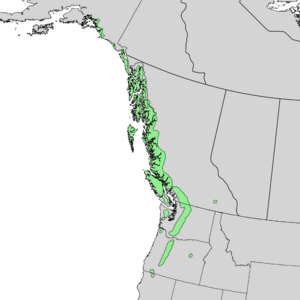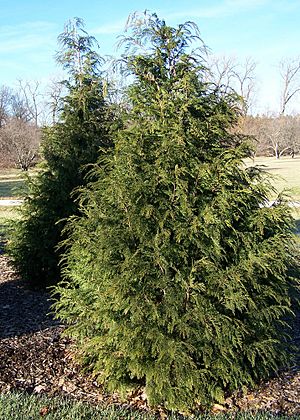Callitropsis nootkatensis facts for kids
Quick facts for kids Callitropsis nootkatensis |
|
|---|---|
 |
|
| Foliage and green cone, Mount Rainier National Park | |
| Conservation status | |
| Scientific classification | |
| Genus: |
Callitropsis
|
| Species: |
nootkatensis
|
 |
|
| Natural range of Cupressus nootkatensis | |
| Synonyms | |
|
|
The Nootka cypress (scientific name: Callitropsis nootkatensis) is a type of tree in the cypress family. It grows naturally along the coast of northwestern North America. You might also hear it called yellow cypress, Alaska cypress, or Alaska yellow cedar.
Its scientific name, nootkatensis, comes from the Nuu-chah-nulth people (formerly called Nootka). These First Nation people live on Vancouver Island in British Columbia, where Europeans first found this tree.
Contents
About the Nootka Cypress
The Nootka cypress is an evergreen conifer, which means it keeps its needles all year. It can grow up to 40 meters (about 130 feet) tall. Some very old trees can even reach 60 meters (about 200 feet). Their trunks can be as wide as 3.4 to 4 meters (11 to 13 feet).
The bark of young trees is thin and smooth, with a purplish color. As the tree gets older, its bark becomes flaky and gray. Its branches often hang downwards, and its leaves are flat and dark green. These scale-like leaves are about 3 to 5 millimeters (0.1 to 0.2 inches) long.
The tree's cones are small, about 8 to 14 millimeters (0.3 to 0.5 inches) wide. They have 4 to 6 scales and take two years to fully grow. The seeds inside the cones are small and have wings, which helps them spread.
Some Nootka cypress trees are incredibly old. In the Caren Range in British Columbia, one tree was found to be 1,834 years old. Some scientists believe other trees there might be over 3,000 years old!
The Nootka cypress is also one of the parent trees of the Leyland cypress. This is a popular hybrid tree often planted in gardens.
Tree Names and Science
Scientists sometimes change a tree's name as they learn more about it. The Nootka cypress has had a few different scientific names over time.
It was first named Cupressus nootkatensis in 1824. Later, in 1841, it was moved to the Chamaecyparis group because its leaves looked similar. However, its cones were more like those of Cupressus trees.
New studies using DNA (genetic evidence) showed that it didn't fit well with Chamaecyparis. For a while, it was placed in a new group called Xanthocyparis. This group also included a newly found tree from Vietnam.
More recent studies, especially in 2021, have shown that the Nootka cypress belongs in its own distinct group called Callitropsis. So, its current accepted scientific name is Callitropsis nootkatensis. This shows how scientists keep learning and updating our understanding of nature!
Where Nootka Cypress Grows
This tree likes moist areas in the coastal mountains of the Pacific Northwest. You can find it from the Kenai Peninsula in Alaska all the way down to the Klamath Mountains in northern California.
It often grows at higher elevations than other trees, sometimes even in very rocky places. In Southeast Alaska, it grows between 600 to 750 meters (about 2,000 to 2,500 feet) high. In British Columbia and Oregon, it can be found between 750 and 2,000 meters (about 2,500 to 6,500 feet).
How the Tree Lives
The Nootka cypress thrives in areas with lots of rain or snow, especially if the snow is deep. The snow helps protect its shallow roots from very cold winter temperatures. Its flexible branches usually don't break under heavy snow.
This tree can grow in the shade, but it grows slowly. Special chemicals inside the tree help it live a very long time. It usually doesn't get many insect problems, but it can sometimes get a disease called heart rot.
In Alaska, many "yellow cedar" trees have been dying off. Scientists have found that this is happening because of climate change. The warmer temperatures mean less snow, and the tree's roots are no longer protected from the cold. This problem affects about 7% of where the tree grows. The U.S. Fish & Wildlife Service is looking into whether the tree needs to be protected as an endangered species.
Uses of Nootka Cypress
The Nootka cypress has been very important to the indigenous peoples of the Pacific Northwest Coast. They used its strong inner bark for many things. While they used western redcedar for big projects like houses, Nootka cypress bark was used for smaller items. This included canoe paddles, baskets, and even thread for clothes and blankets.
The wood of the Nootka cypress is considered one of the best in the world. It has been sent to countries like China for many years. People use it for floors, inside buildings, and for building boats.
It's also a great source of firewood because it burns very hot and for a long time. Even a tree that died 100 years ago can still be used for firewood!
Building with Nootka Cypress
The wood of the Nootka cypress is excellent for building. It is hard and lasts a long time, even in bad weather. It also resists insects and rot when it touches the soil.
It's easy to work with using hand tools or machines. You can glue, screw, or nail it together. The wood has a smooth texture, even color, and straight grain, which makes it look nice when finished. It doesn't splinter easily and wears well over time. When it's first cut, it has a slightly bitter smell, but once it dries, it has almost no smell. This is why it was traditionally used for face masks.
Because it can be expensive, it's often used for special finishing work. This includes outside siding, roof shingles, decks, and cabinets. It can also be used to replace other types of wood that are now harder to find.
Other uses for Nootka cypress wood include saunas and battery containers. This is because it can resist acids. Long ago, people also made paddles, masks, dishes, and bows from its wood.
Nootka Cypress in Gardens
The Nootka cypress looks beautiful in parks and large gardens because its branches hang down gracefully. It can also be trimmed to make a tall hedge.
It grows best in places with cool summers and well-drained soil. It likes some shade but can also grow in full sun. It is sometimes used in bonsai, which is the art of growing miniature trees.
A special type of Nootka cypress called 'Pendula' has won an award for being a great garden plant.
Nootka Cypress in Indigenous Stories
The Hesquiaht First Nation, part of the Nootka peoples, has a legend about how the Nootka cypress came to be.
The story says that a raven met three young women drying salmon. He asked if they were afraid of animals like bears or wolves. The women said no, but they were afraid of owls. The trickster raven then hid and made owl sounds. The terrified women ran up the mountains. When they ran out of breath, they turned into Nootka cypress trees.
This legend explains why Nootka cypress trees grow on mountain sides. It also says that the tree's bark is silky like a woman's hair, and its young trunk is smooth like a woman's body.
In Tlingit culture, there is a story about Natsilane. This story tells how a Nootka cypress tree was used to carve the world's first killer whale.
Gallery
-
Young tree in North Cascades National Park
See also
 In Spanish: Falso ciprés de Nutca para niños
In Spanish: Falso ciprés de Nutca para niños










